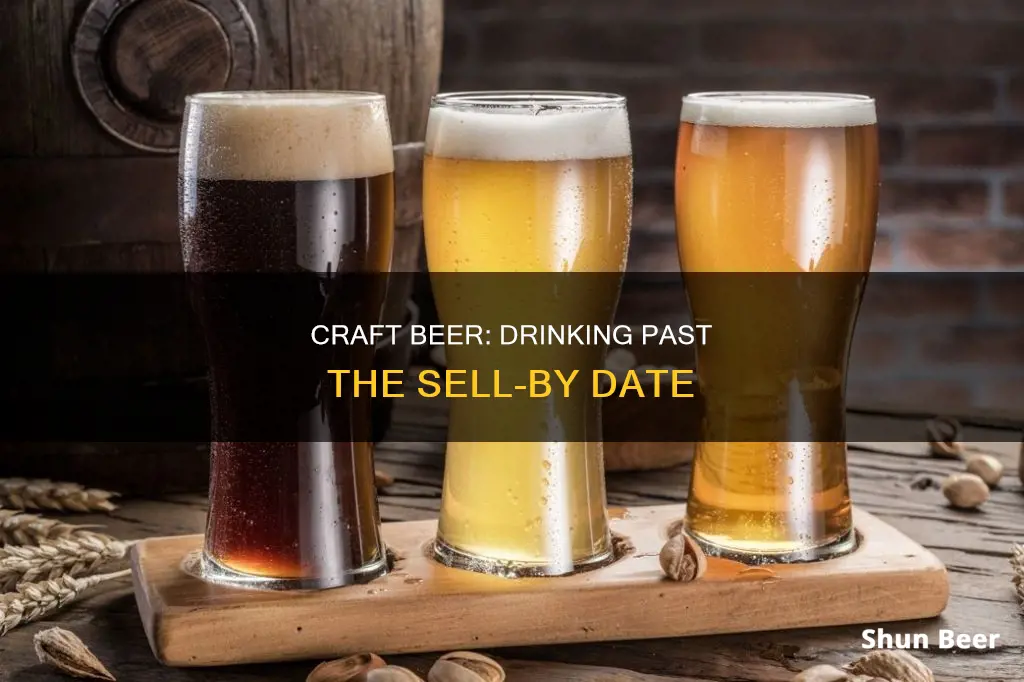
It's generally safe to drink craft beer past its sell-by date, as the date indicated is typically a 'best before' rather than a 'use by' date. This means that while the beer may not taste as good as it once did, it won't make you sick. That being said, the way the beer was stored will affect its taste and safety. Beer is sensitive to light and temperature changes, so it's best stored in a cool, dark place.
| Characteristics | Values |
|---|---|
| Is it safe to drink craft beer past the sell-by date? | Yes, beer has no use-by date, so it is safe to drink well past the best-before date. |
| Will the beer taste the same? | The taste of the beer will deteriorate over time. |
| How long does beer last past its best-before date? | A standard light lager will last around 6 months to 2 years after the best-before date if kept in the fridge and 6–9 months if kept in the cupboard. |
| What factors affect how long beer lasts? | The type of beer and how it is stored. Beers with higher alcohol content (around 9%) can taste better over time. Beers made with organisms other than yeast, such as lambics, gueuzes, and saisons, can also age well. |
| How should beer be stored? | Beer should be kept in the fridge or in a cool, dark place. Beer is sensitive to light and dramatic temperature changes, which can affect its taste. |
What You'll Learn

Is it safe to drink beer past its sell-by date?
Beer is usually marked with a 'best before' date, which is different from a 'use by' date. This means that it is safe to drink past the date on the container, but the taste of the beer will deteriorate over time. The amount of time it takes for beer to lose its taste depends on the type of beer, how it is stored, and whether it is bottled or canned.
A typical lager will be drinkable 6–24 months after its best-before date if it has been kept in the fridge. That timeframe tops out at 9 months if it hasn't been refrigerated. Beers with higher alcohol content, such as imperial stouts and porters, can be drinkable for 5–10 years or more, depending on the beer. Beers that are unfiltered or unpasteurized will also last longer.
Some beers, like wine, actually improve with age. Richer and higher ABV varieties of beer, such as porters and stouts, can get better with age if kept in cool, dark storage conditions like a basement or cellar. Beers with lower alcohol content, such as lagers, biere de gardes, pale ales, and IPAs, do not age as well and are best drunk sooner rather than later.
The main enemies of beer are light and temperature changes. Beer is very sensitive to light, and exposure to it can create the "skunked" flavour often associated with off beer. Beer should be stored in a cool, dark place, and if it has come from a supermarket fridge, it should be kept in the fridge at home as well.
While drinking beer that is past its best-before date is not dangerous, it may not taste very good. The beer will likely be stale, oxidized, and may have a cardboard or soy sauce-like flavour. It may also be flat, and the alcohol content may be reduced.
Beer and Metro North: What's Allowed?
You may want to see also

How does beer taste after its sell-by date?
Beer typically has a 'best before' date, rather than a 'use by' date. This means that it is still safe to drink after this date, but the flavour and aroma may have deteriorated. The taste of beer past its sell-by date will depend on the type of beer and how it has been stored.
Lagers, for example, will typically be drinkable for 6-9 months after their best before date if they have been kept in a cool, dry place or refrigerator. However, IPAs—especially hoppy ones—will lose their flavour and aroma over time and are best consumed before their best before date.
Richer, higher ABV beers such as porters and stouts can improve with age if stored in cool, dark conditions. This is because the yeast in the beer continues to consume sugar and oxygen, altering the flavour profile.
Other signs that a beer has gone bad include a bad aroma, a lack of the usual 'pssst' sound when opening, and excessive sediment at the bottom of the bottle.
Drinking Beer in NYC: Open Secrets and Legalities
You may want to see also

How to store beer to extend its shelf life?
Beer is best stored in a cool, dark place, such as a basement or a closet. The optimal temperature range for storing beer is between 45 and 55 degrees Fahrenheit. If you don't have access to a temperature-controlled space, a regular refrigerator will also work. Beer should be stored upright to minimize the amount of surface area that comes into contact with air.
If you're storing beer in a bottle, make sure to keep it away from direct sunlight and fluorescent light, as this can cause the beer to become "skunked" or "lightstruck". This happens when the beer's UV rays break down, causing a chemical reaction that affects its flavour and aroma.
It's also important to note that not all beers age the same way. Beers with a higher ABV (above 8%) tend to have a longer shelf life and can be stored for longer periods. Sour and smoked beers also fall into this category. On the other hand, IPAs and other hop-centric beers, such as amber lagers and American pale ales, will age more quickly and are best consumed fresh.
Additionally, pasteurized beer will last longer than unpasteurized beer. Unpasteurized beer should be consumed within three months of bottling and stored in the fridge during that time. Pasteurized beer can be stored for several months at room temperature or up to a year in the refrigerator.
Does Helium-Infused Beer Really Work?
You may want to see also

What are the signs of bad beer?
Beer typically has a 'best before' date, which is different from a 'use by' date. While it's not advisable to consume food past its 'use by' date, a 'best before' date is more of a guideline on quality. Beer will start to lose its quality after its 'best before' date, but it can still be consumed. The timeframe for drinking beer after its 'best before' date varies depending on the type of beer and whether it has been refrigerated. A typical lager will be drinkable 6–24 months after its 'best before' date if it's been kept in the fridge, and up to 9 months if it hasn't been refrigerated.
Some beers, like porters and stouts, can improve with age, especially if they're stored in cool, dark conditions. On the other hand, IPAs, especially hoppy ones, gradually lose their flavour and aroma over time.
- Bad aroma: Beer should have a pleasant aroma, so if it smells unpleasant, it's likely gone bad. A skunky smell is a common indicator of bad beer. This can occur when beer is exposed to UV rays and coloured glass that doesn't block out the rays. However, some beers, like Heineken, are bottled in coloured glass and are meant to have a skunky smell.
- Lack of fizz: When you open a fresh beer, it should have a characteristic fizz and foaming at the top. If it's missing this, it could be a sign that it has gone bad.
- Excessive sediment: Checking the bottom of the bottle for excessive sediment can help you avoid a poor-tasting beer.
- Oxidation: If beer comes into early contact with oxygen, it can undergo oxidation, resulting in a stale, cardboard-like taste.
- Off flavours: While there are many unusual beer flavours, some flavours indicate that the beer has gone bad. These include flavours like cooked cabbage, sewage, sulphur, or an abnormally sour taste. Additionally, a buttery or popcorn-like flavour can indicate the presence of diacetyl, which, in excessive amounts, can be harmful to your lungs.
Beer and Fatty Liver: A Dangerous Combination
You may want to see also

What are the different types of beer and their shelf life?
Beer is typically labelled with a 'best before' date, which is different from a 'use by' date. 'Use by' dates are a rule, and after the stated date, the product will quickly degrade and may cause illness. 'Best before' dates are a guideline on quality rather than safety, and the product will begin to lose its quality after the stated date but can still be consumed. Beer typically has a 'best before' date.
The shelf life of beer varies depending on the type. Lagers have a relatively long shelf life, remaining drinkable for 6-24 months after their best-before date if refrigerated, and up to 9 months if not. Stouts and porters, which are richer and have a higher ABV, can also improve with age, especially if stored in cool, dark conditions. IPAs, on the other hand, do not age well, and it is recommended to consume them as soon as possible, as they gradually lose their flavour and aroma.
Beer's Anti-Inflammatory Benefits: Fact or Fiction?
You may want to see also
Frequently asked questions
Yes, you can. Beer has a 'best before' date, which is different from a 'use by' date. This means that it is safe to drink beer past its sell-by date. However, the taste of the beer will deteriorate over time, and it may taste stale or flat.
The duration varies depending on the type of beer and how it is stored. A standard lager or IPA will last around 6 months to 2 years past its sell-by date if kept in the fridge, and 6-9 months if stored in a cupboard. However, some beers with higher alcohol content, such as barley wines, porters, and imperial stouts, can taste better with age and can be stored for much longer.
Beer that has gone bad will have an obvious bad aroma. It may also be missing the usual 'pssst' sound and foaming when opened. Additionally, excessive sediment at the bottom of the bottle can contribute to a poor taste.







